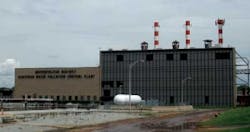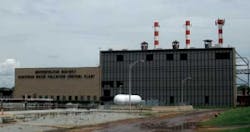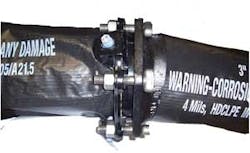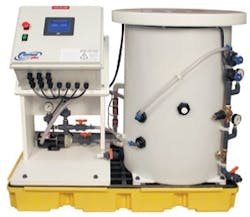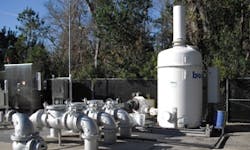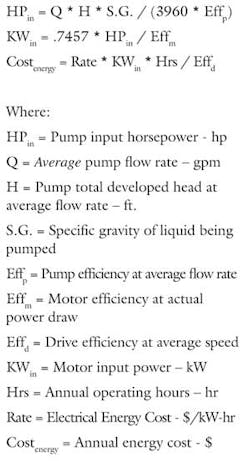Steps to Realizing Calculated Pump System Energy Savings
By Allan R. Budris
When considering possible changes or options to reduce pump system energy costs, care must be taken not to base the decision on insufficient or overly optimistic data. During an industrial energy audit which the author conducted several years ago, he was asked to look into a pump system that was previously evaluated by another consultant, who used an abbreviated costing method. This short-cut calculation predicted an annual savings of $50,000 (by replacing a control valve with a variable speed drive). However, a more thorough evaluation conducted by the writer (which included field testing), showed the annual savings to be closer to $5,000, not enough to justify the VFD.
Variable Frequency (Speed) Drives can yield substantial savings in the right application, and they almost always yield the lowest energy cost. However, these savings may not be enough to justify the total capital VFD investment in many applications.
Average Flow Rate
One of the best ways to begin the process of obtaining a reasonably accurate estimate of the current (or future) pump system energy costs (and potential savings), is to determine the average expected pump flow rate. The writer has found that using the average pump flow (and head), over the total annual pump hours of operation, yields input energy results that are very close to the energy costs determined by the more time consuming method of summing up the various individual pump head-capacity values, for the time spent at each of the individual conditions.
Often pump operating conditions (at least the flow rate) can be obtained from existing system records. If actual pump field head-capacity test results are not available, the pump factory H-Q and efficiency curves can be used, at the pump speed, for a reasonable first approximation.
Figure 1 shows the actual nine month historical flow rates for a pump the writer has previously analyzed, broken down between low, average and high flow rates, with Figure 2 summing up the average time spent at each of the flow rates. The maximum overall flow rate (1,600 gpm in this case) should determine the pump size, with the selected pump also being capable of satisfactory operation at the minimum flow rate (550 gpm). It is, however, the average flow rate (988 gpm) and the associated pump and system heads, which should be used for any initial reasonable energy usage calculation.
Potential Energy Savings
As can be seen in Figure 3 (which depicts a friction head loss, valve controlled system), and related Table 1, the lower the flow rate the greater the wasted pressure (energy) across a control valve. If the average flow rate coincides with the point at which the pump and system H-Q curves intersect (1,600 gpm in Table 1), then no energy will be saved, by changing to a variable speed drive. On the other hand, if the average pump flow rate is much less then this value (say 988 gpm in this example), a sizable savings (up to 69%) may be possible. This is still, however, substantially less than the 91% valve for the minimum flow rate (550 gpm). It should be noted that the "valve loss" energy saving values shown in Table 1 are for an all "friction" head loss system. The losses (and potential savings) will be less when the system H-Q curve has a static pressure component (see Figure 4). It is difficult to justify a variable frequency drive when the system H-Q curve is predominately made up of this "static" component.
It should further be noted that not all of the valve loss energy can be recovered with a variable frequency drive. The VFD drive efficiency and the reduced motor efficiency (at the reduced pump/motor speed) must be taken into account, as shown in the below formula for the energy cost calculation..
Other Control Methods
A Variable Speed/Frequency Drive is normally not the only option that should be considered for reducing the pump energy cost. Lower cost options such as an impeller trim, alternate impeller or reconditioning of the pump should also be considered, as well as other control methods as discussed in the writer's September 2011 column, which are listed below. Variable Speed Drives are, however, more easily adapted to existing systems than some of the other control methods, plus the lower speeds increase pump life.
Centrifugal Pump Control Methods
- Stop-Start / Float Level control Operation
- Control Valve Operation
- By-Pass Valve Operation
- Variable Speed Operation
- Hybrid Control (VFD + By-Pass)
- Parallel Operation of Multiple Pumps
- Multiple Speed Motors (2, 3 or 4 Speed)
Calculator Tools
Various companies have developed online and even mobile software applications that simplify the calculation of the potential energy savings derived from variable frequency drives, and other pump energy savings methods. They range from the simplified (basic) Rockwell Automation Energy Saving Calculators, to the more detailed Department of Energy, Pump System Assessment Tool (PSAT), and the Hydraulic Institutes' Pump System Matter PSIM.
The Rockwell Basic tool only requires minimal input, which includes: pump minimum flow, percent pressure rise and efficiency values, system static head, motor power rating, speed and efficiency, plus operating time and kilowatt cost. Although the easiest, this method could greatly over estimate the potential energy savings through use of the minimum and not average flow rate, plus the use of the rated motor power instead of the pump input power at the average flow rate. To be fair, Rockwell does have more detailed "Energy Savings Calculators" (Intermediate and Advanced), which address these major short comings, but they do require substantially more input data. Also, the only energy saving option considered with the Rockwell Calculators is a VFD.
Conclusion
The take away from this column should be that, although simplified Pump Energy Calculator tools may be helpful in identifying potential energy savings candidates, (albeit the average pump flow rate should still be used instead of the minimum flow), before committing a large capital investment towards the identified energy savings option, a more detailed, extensive study should be conducted, to insure that the expected savings will be realized. This extensive energy audit might want to include a qualified consultant and/or possibly field testing for more complex pump systems, or where the current system has critical unknowns.
More WaterWorld Current Issue Articles
More WaterWorld Archives Issue Articles
